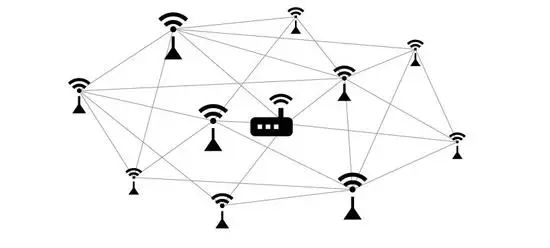
Source: Curiosity Daily
Published by IoT Think Tank
Please cite the source and origin
—— [Introduction] ——
The Bluetooth Special Interest Group has officially announced a new Bluetooth connection standard that supports mesh networking protocols.

The Bluetooth Special Interest Group has officially announced a new Bluetooth connection standard that supports mesh networking protocols. This new network structure is suitable for smart buildings, stadiums, or smart homes with a large number of Bluetooth devices.
A mesh network is a connection structure that interconnects all Bluetooth devices within a region. The simplest method for device network connectivity is to connect all these devices together; for example, if there are six Bluetooth devices, a fully interconnected network structure would require 15 transmission lines.

Figure: Simple mesh network diagram
The advantage of this connection method is that all Bluetooth devices in the network can communicate as nodes. This avoids the situation where the entire system cannot connect and operate if some nodes fail. Moreover, if a node is attacked externally, the mesh network can isolate all connections to the dangerous node.
Since each device can transmit information, this is beneficial for large venues, office buildings, and stadiums that require long-distance information transmission. Devices within the mesh network can transmit with very low power consumption, allowing battery-powered temperature controllers commonly found in stadiums or office buildings to operate for longer periods.
A larger issue is distance. Currently, large Bluetooth networks generally adopt a centralized control network structure, where nodes in the network connect to a central node (also known as a central hub) via point-to-point connections, typically controlled by a hub or switch.
In this network structure, any two Bluetooth devices must communicate through the central node control—they must be close enough to the node. Additionally, Bluetooth connections are inherently unstable and slow; if the central node fails or is attacked, the entire Bluetooth network cannot communicate properly.
In contrast, a point-to-point mesh network avoids these issues. The current concept is that when the smart building system sets the office door lock, it automatically turns off all lights in the office. If the central control device fails and cannot operate, the Bluetooth access control can still transmit the off command to the smart light switch, ensuring that the instruction can be executed normally.

The reason why mesh network connection technology has only recently received support from the Bluetooth Special Interest Group is that this structure is relatively complex to control, and the installation and configuration requirements are quite high when dealing with a large number of Bluetooth devices.
On the other hand, the development of smart homes has been too slow. Although manufacturers find the ZigBee protocol cumbersome (for example, Philips Hue requires a separate controller similar to a router, just to install a few light bulbs), and it is incompatible with existing Wi-Fi and Bluetooth, there are still not many users of smart homes.
The Bluetooth Special Interest Group is a non-profit organization with over 30,000 member companies worldwide and is the standard setter for Bluetooth technology. The founding companies of the alliance, including Agere, Ericsson, IBM, Intel, Microsoft, Motorola, Nokia, and Toshiba, have the authority to drive updates to the Bluetooth standard. In 2006, Lenovo replaced IBM as a member of the Bluetooth Special Interest Group board. Google also became a board member on July 14 of this year.
Currently, Bluetooth Low Energy devices that support Bluetooth 4.0 and 5.0 can await manufacturers to develop firmware upgrades to gain access to mesh networking capabilities.
However, Bluetooth usage remains one of the most troublesome aspects of common consumer electronics. Apple is working to improve the Bluetooth experience by incorporating its own designed chip into AirPods wireless headphones. Several new and upcoming third-party wireless headphones are also doing similar things.
If improvements are not made quickly, Bluetooth may fail to achieve true universality.

Previous Popular Articles (Click on the title to read directly):
-
“How Difficult is it to Create Smart Locks for Shared Bicycles?”
-
“Cognitive Computing, Blockchain IoT, IoT Security… Those Who Understand Will Control the Future”
-
“KUKA, ABB, Fanuc, Yaskawa, Four Industrial Robot Giants Have Long Been Preparing in the IoT Field”
-
“[Heavyweight] IoT Industry Panorama Report, The First Domestic IoT Industry Two-Dimensional Perspective Panorama”
-
“A Cartoon Explains: Besides WiFi and Bluetooth, What Can the Recently Popular NB-IoT Do?”
-
“A Cartoon Explains: What is LoRa, which Everyone is Talking About Behind NB-IoT?”
